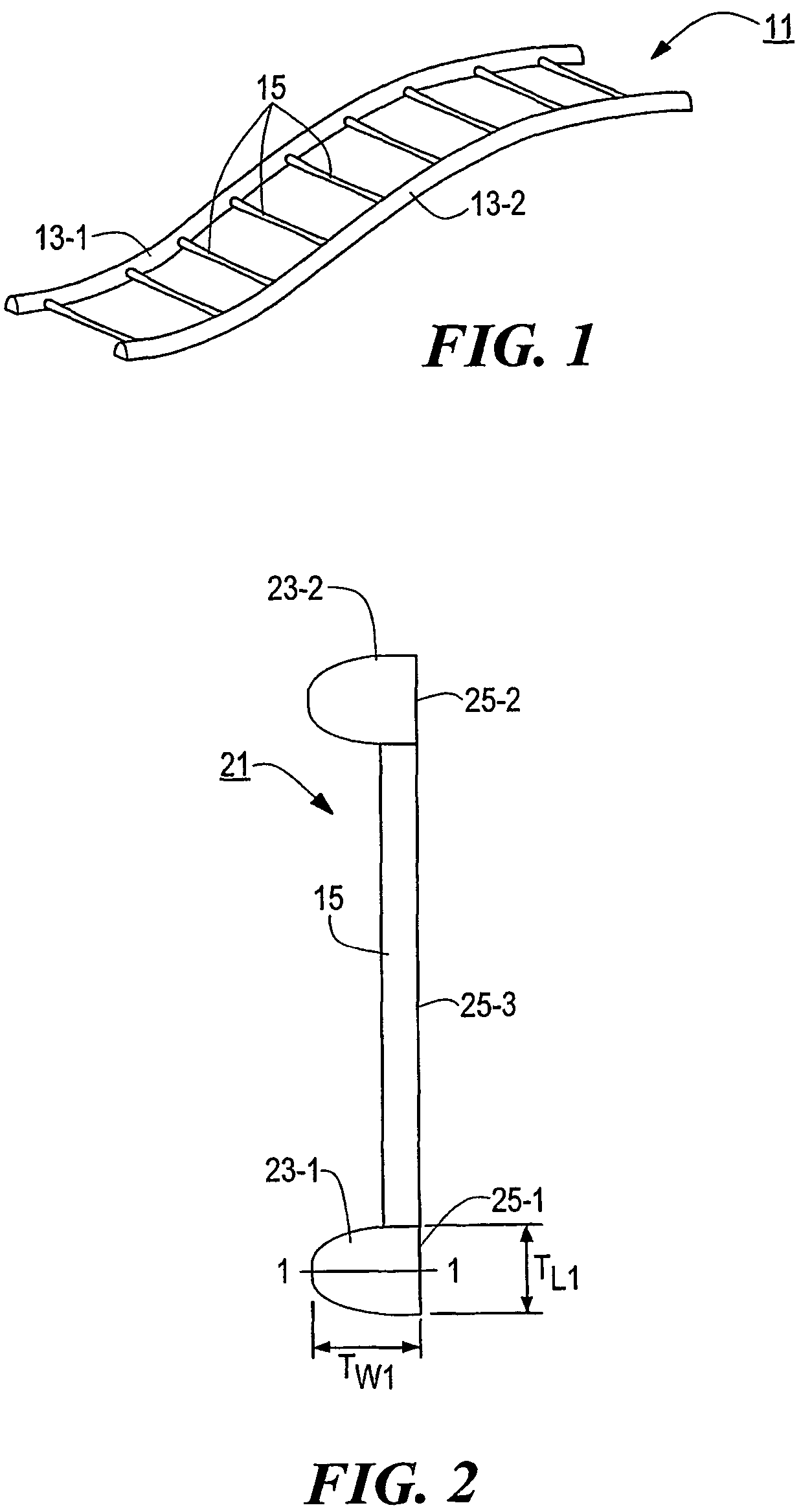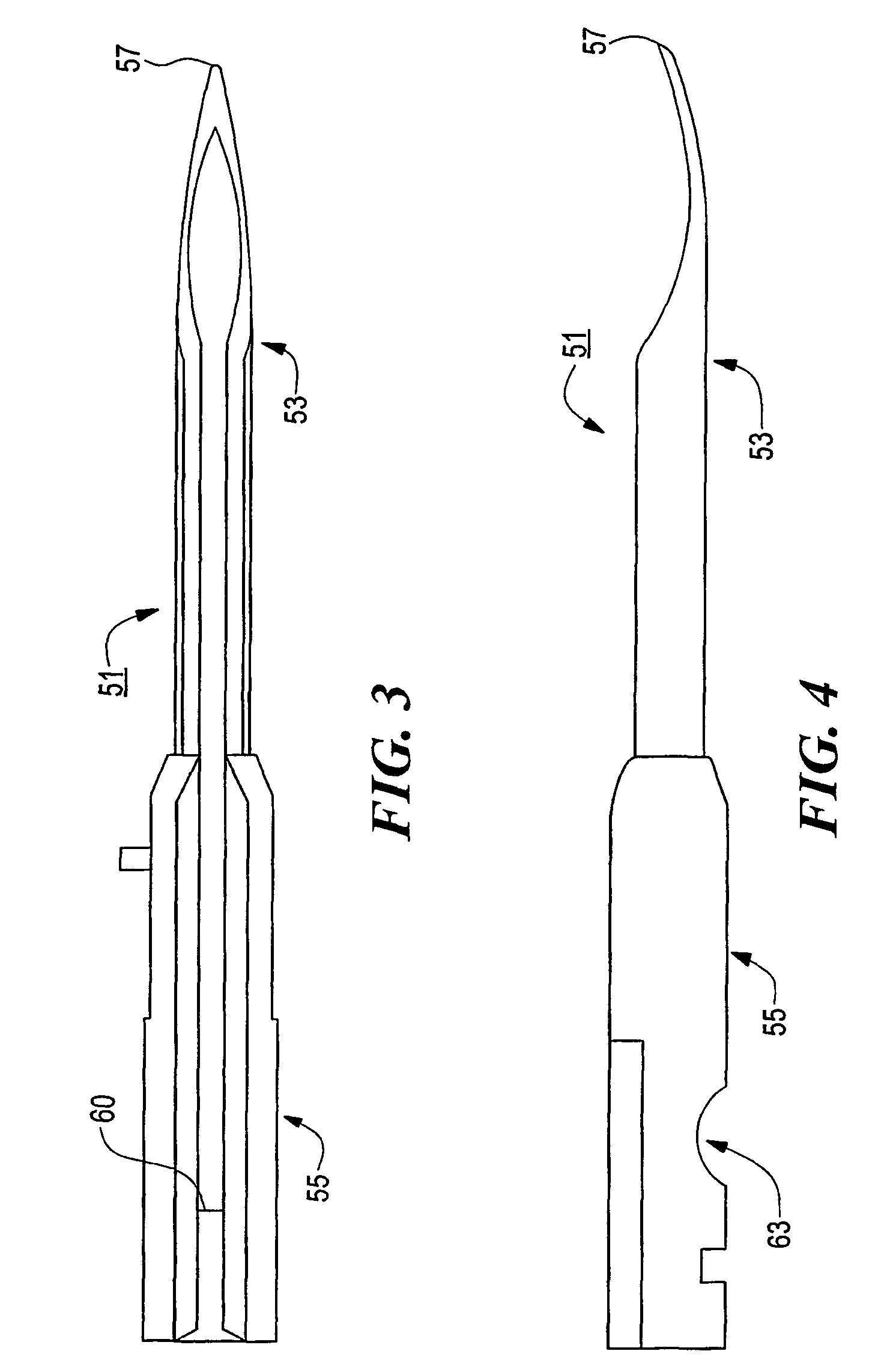Plastic fasteners, needles for dispensing and method of manufacture
a technology of plastic fasteners and needles, applied in the direction of identification means, instruments, seals, etc., can solve the problems of undesirable results, inability to achieve the proper engagement of the cross-bar by the ejector rod and the proper translational movement of the cross-bar through the length of the bore due to the action of the ejector rod, and the failure of the tool to work properly
- Summary
- Abstract
- Description
- Claims
- Application Information
AI Technical Summary
Benefits of technology
Problems solved by technology
Method used
Image
Examples
first embodiment
[0062]Referring now to FIG. 7, there is shown a left side view of a needle constructed according to the teachings of the present invention, the needle being represented generally by reference numeral 101.
[0063]Needle 101 comprises a stem portion 103 and a base portion 105. Base portion 105, which is identical in all respects to base portion 55, may be made by insert-molding plastic onto the rear end of stem portion 103.
[0064]Stem portion 103 is similar in certain respects to stem portion 53. For example, stem portion 103 is an elongated member terminating at its front end in a spoon-shaped tip 107, tip 107 being sufficiently sharp to enable its penetration into a desired article of commerce. However, as shown in FIG. 8, stem portion 103 differs markedly from stem portion 53 in that stem portion 103 has a generally “d”-shaped transverse cross-section, instead of the generally annular transverse cross-section of stem portion 53. As such, stem portion 103 defines a generally semi-ellip...
second embodiment
[0067]Referring now to FIG. 9, there is shown a transverse section view of a stem portion of a needle constructed according to the teachings of the present invention, the stem portion being represented generally by reference numeral 151.
[0068]Stem portion 151 is identical in virtually all respects to stem portion 103, the principal difference between stem portion 151 and stem portion 103 being that stem portion 151 is shaped to define a generally rectangular bore 153, instead of the generally semi-elliptical bore 109 of stem portion 103. Bore 153 has a transverse cross-sectional height h1 and a transverse cross-sectional width w3, height h1 being greater than width w3 and extending parallel to the length of a filament in slot 155.
[0069]Stem portion 151 is preferably made in the same manner as stem portion 103, and a suitably shaped base portion (not shown) is preferably insert-molded onto the rear end of stem portion 151 in the conventional manner.
[0070]Because of the generally rect...
third embodiment
[0075]Referring now to FIG. 14, there is shown a fragmentary perspective view of a needle constructed according to the teachings of the present invention, said needle being represented generally by reference numeral 251.
[0076]Needle 251 comprises a stem portion 253 and a base portion (not shown), said base portion being similar to base portion 55 and preferably being made by insert-molding plastic onto the rear end of stem portion 253.
[0077]Stem portion 253 is similar in many respects to stem portion 103. For example, stem portion 253 is an elongated member terminating at its front end in a spoon-shaped tip 257, tip 257 being sufficiently sharp to enable its penetration into a desired article of commerce. However, as seen best in FIG. 15, stem portion 253 differs primarily from stem portion 103 in that stem portion 253 has a longitudinal bore 259 of a generally “B”-shaped transverse cross-section, instead of the generally semi-elliptical bore 109 of stem portion 103. Bore 259 is bou...
PUM
 Login to View More
Login to View More Abstract
Description
Claims
Application Information
 Login to View More
Login to View More - R&D
- Intellectual Property
- Life Sciences
- Materials
- Tech Scout
- Unparalleled Data Quality
- Higher Quality Content
- 60% Fewer Hallucinations
Browse by: Latest US Patents, China's latest patents, Technical Efficacy Thesaurus, Application Domain, Technology Topic, Popular Technical Reports.
© 2025 PatSnap. All rights reserved.Legal|Privacy policy|Modern Slavery Act Transparency Statement|Sitemap|About US| Contact US: help@patsnap.com



